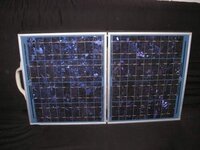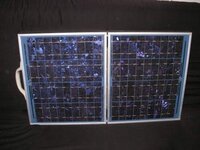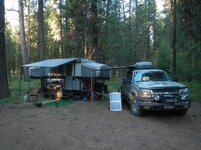- Messages
- 4,156
- Reactions
- 2,244
I have been doing tons of reading on solar stuff. While there is quite a bit of info out there on it much of it just seems to be the same info over and over again.
So I am trying to set up a solar charging system in my enclosed trailer.
I currently have 2, 6v batteries with 225ah (20 hour) reserves. They are wired in series to give me 12v and if I understand correctly I still only have 225ah reserve.
I have installed 2 fans (fantastic's) that draw 3A each for a total of 6A. I would like to be able to run these all day to pull warm air out and probably most the night to pull cool air in. I have some interior lights that will run for short bits (under 30 min) in the evenings and morning. I have no plans of using much else for power on a regular basis most the time. Just to be on the safe side I have been saying I want to pull 10A, 24hr/day on the couple calculators I could find online. I know my batteries are just undersized for that.
I am trying to figure out how many panels I will need. I found a 235 watt panel for a good price but according to the calculator I would need 3 to do what I want. The calculator I could find would not convert voltage and amps. The panel I am looking at is rated at 30v to get the 235 watts that is 7.8 amps which I know does not work. If I am reading right if I get a MPPT controller that will bring it back to 12v but that will also give me about 19.5A to get the 235 watts. Am I understanding that right?
So that leads to the next part. This time of year we have 14 hours of daylight. I know the panel will not put out full power that whole time but is it reasonable to believe there is 7hr of good sun this time of year?
Can I get by with 1 panel or do I need 2? Obviously the price of 2 doubles my cost. Plus MPPT's are not cheap either.
I know I am missing some info and some questions in there. Any help getting this straightened out would be nice.
So I am trying to set up a solar charging system in my enclosed trailer.
I currently have 2, 6v batteries with 225ah (20 hour) reserves. They are wired in series to give me 12v and if I understand correctly I still only have 225ah reserve.
I have installed 2 fans (fantastic's) that draw 3A each for a total of 6A. I would like to be able to run these all day to pull warm air out and probably most the night to pull cool air in. I have some interior lights that will run for short bits (under 30 min) in the evenings and morning. I have no plans of using much else for power on a regular basis most the time. Just to be on the safe side I have been saying I want to pull 10A, 24hr/day on the couple calculators I could find online. I know my batteries are just undersized for that.
I am trying to figure out how many panels I will need. I found a 235 watt panel for a good price but according to the calculator I would need 3 to do what I want. The calculator I could find would not convert voltage and amps. The panel I am looking at is rated at 30v to get the 235 watts that is 7.8 amps which I know does not work. If I am reading right if I get a MPPT controller that will bring it back to 12v but that will also give me about 19.5A to get the 235 watts. Am I understanding that right?
So that leads to the next part. This time of year we have 14 hours of daylight. I know the panel will not put out full power that whole time but is it reasonable to believe there is 7hr of good sun this time of year?
Can I get by with 1 panel or do I need 2? Obviously the price of 2 doubles my cost. Plus MPPT's are not cheap either.
I know I am missing some info and some questions in there. Any help getting this straightened out would be nice.


















